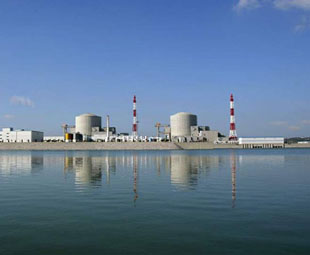As one of the world's fastest growing economies and the second largest consumer of energy, China is looking more to nuclear power to better distribute its energy sources.
Shandong in East China is one example of how this shift is playing out: There are plans afoot to build three nuclear power plants in the province, two in Weihai and one in Yantai.
The plants are expected to house five reactors with a combined capacity of more than 4,000 mW. Once these plants are finished, Shandong will become an important nuclear power base for the country.
Statistics show that nuclear power has become the third most important power source in China.
There are currently 11 nuclear reactors in operation, with a total capacity of around 8,000 mW.
The country's nuclear power plants generated 62.9 billion kWh last year, representing an increase of 14.6 percent compared with a year earlier, according to the Commission of Science Technology and Industry for National Defense.
"China's nuclear power industry has experienced a transition from appropriate development to accelerated development," Han Wenke, deputy director of the Energy Research Institute under the National Development and Reform Commission (NDRC), said.
At present, nuclear power accounts for less than 2 percent in the country's total power generation.
The authorities plan to increase the country's nuclear power capacity to 40,000 mW by 2020, which would take the sector's share of the total power industry to 4 percent.
Worldwide, nuclear power accounts for 16-17 percent of all power generation.
In countries like France, nuclear power even accounts for around 80 percent of the industry.
All of China's existing nuclear power plants are located in coastal areas.
Coastal provinces such as Zhejiang, Fujian and Guangdong have all said they are preparing sites to host new nuclear stations.
Several inland regions have also taken part in the development of nuclear power.
Hunan, Hubei, Chongqing have all said they are planning to build China's first inland nuclear power plant.
Construction work started on Sanmen nuclear power plant in Zhejiang province in January.
With two 1,000-mW nuclear reactors using technology from the US-based energy company Westinghouse Electric Co, the plant represents the cutting edge in nuclear power.
Last year China finalized a contract with a consortium led by Westinghouse to build four nuclear power reactors, including two in Sanmen, one in Haiyang, and one in Shandong province.
Compared with earlier generation technology, reactors using third generation technology have longer operational lives and are safer.
Westinghouse said its equipment has been selected for at least 12 reactors in the US to be built over the next 10 to 12 years.
Last year China also signed an 8-billion euro ($11.6 billion) agreement with the French nuclear company Areva to supply two third-generation nuclear reactors for a project in Taishan, Guangdong province.
Construction of the two reactors, each with a capacity of 1,700 mW, could begin fall of 2009.
(China Daily February 13, 2008)


